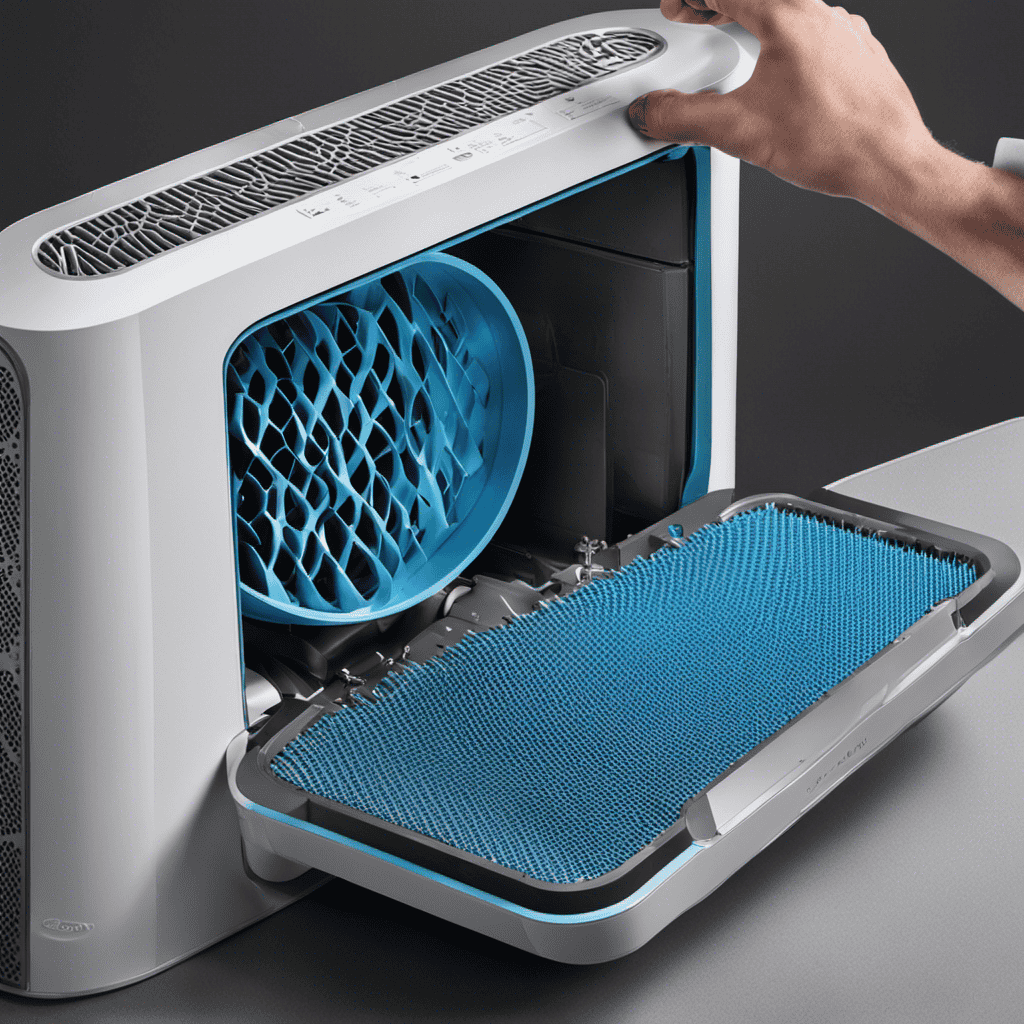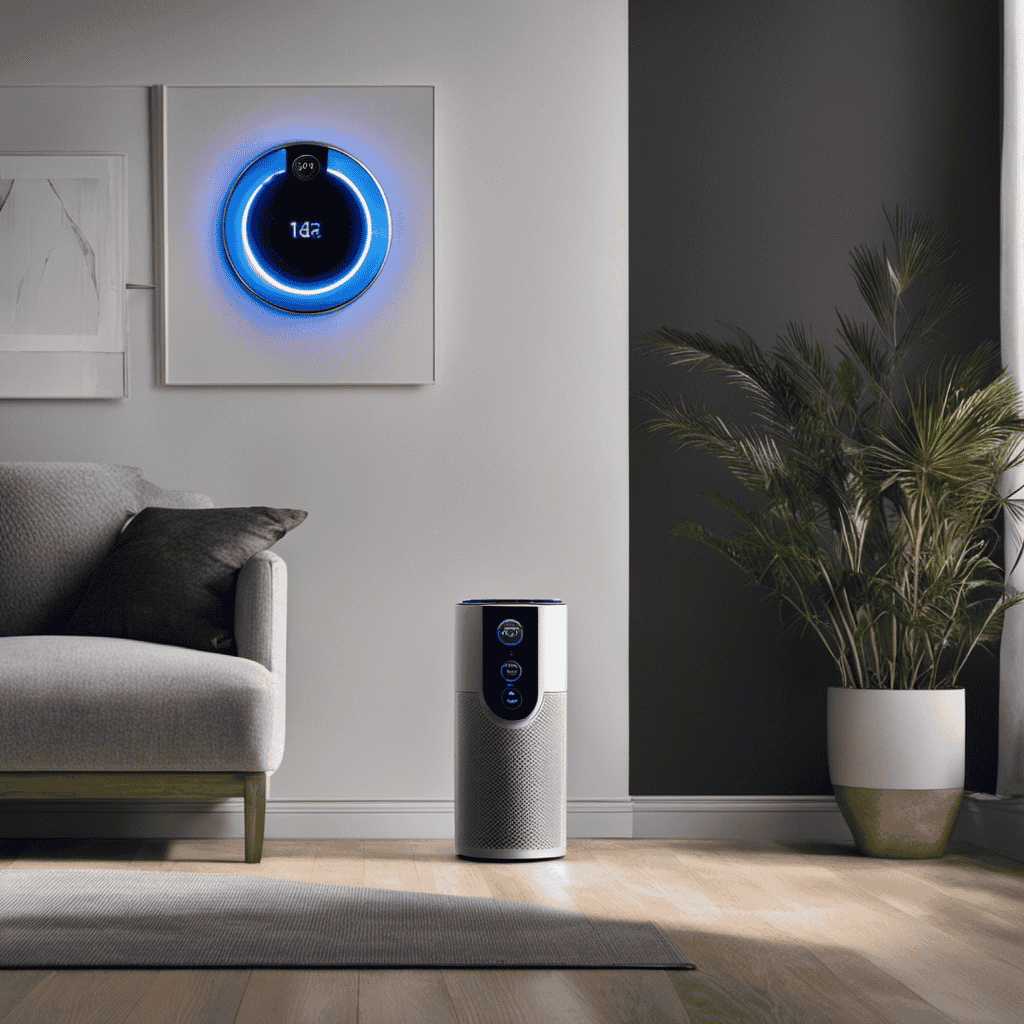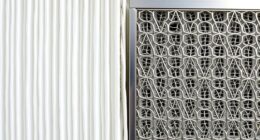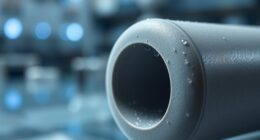I am exploring the world of ozone air purifiers because indoor air pollution is two to five times higher than outdoor air pollution.
In this article, I’ll uncover the science behind these devices, explain how they remove odors, and compare them to HEPA filters.
We’ll also address common misconceptions and discuss safety precautions.
By the end, you’ll have a clear understanding of what ozone air purifiers do and whether they’re the right choice for your needs.
Key Takeaways
- Ozone air purifiers release ozone molecules into the air to neutralize odors and kill bacteria.
- High levels of ozone can be harmful to human health, irritating the respiratory system and worsening existing respiratory conditions.
- Ozone-free air purifiers provide safer and more effective air purification without producing harmful ozone.
- Ozone air purifiers are not designed to target and eliminate allergens and relying solely on them for allergy relief is not recommended.
The Science Behind Ozone Air Purifiers
Now, let’s take a look at how an ozone air purifier actually works.
Ozone air purifier technology utilizes ozone, a molecule composed of three oxygen atoms, to clean and purify indoor air.
Ozone is a powerful oxidizing agent that can break down and eliminate pollutants, such as bacteria, viruses, and odors, in the air.
When ozone is released into the air, it reacts with these pollutants and breaks them down into simpler and less harmful substances.
This process effectively reduces the concentration of airborne contaminants, improving indoor air quality.
However, it is important to note that ozone can be harmful in high concentrations and may have adverse effects on human health.
Therefore, understanding ozone generation in air purifiers is crucial to ensure safe and effective use.
Understanding Ozone Generation in Air Purifiers
When it comes to ozone air purifiers, it is important to understand the effects of ozone on air purification.
Ozone, a highly reactive gas, can effectively eliminate odors and kill bacteria and viruses in the air.
However, there are safety concerns associated with ozone generation, as high levels of ozone can be harmful to human health.
Therefore, it is crucial to explore alternatives to ozone generation in air purifiers that can provide effective air purification without compromising safety.
Ozone’s Air Purification Effects
Using an ozone air purifier can help improve air quality. It eliminates odors and reduces airborne pollutants. Ozone air purifiers work by utilizing ozone, a powerful oxidant. It neutralizes and eliminates harmful substances in the air. Ozone molecules break down and destroy organic compounds like bacteria, viruses, and mold spores. These can cause allergies and respiratory issues. This technology effectively eliminates unpleasant odors caused by smoke, pets, and cooking. Ozone air purifiers also reduce levels of volatile organic compounds (VOCs) present in the air. Formaldehyde and benzene are common indoor air pollutants. However, it’s important to note that ozone air purifiers should be used with caution. High levels of ozone can be harmful to human health. It’s recommended to follow the manufacturer’s instructions and use the purifier in well-ventilated spaces.
Ozone Safety Concerns
It’s important to be cautious when using ozone air purifiers as high levels of ozone can be harmful to human health. Ozone exposure can lead to various health risks, including respiratory issues, throat irritation, and chest pain.
Here are some potential scenarios to help you understand the risks:
- Imagine breathing in an environment with high levels of ozone, where the air feels heavy and difficult to inhale.
- Picture your throat becoming dry and irritated, leading to coughing and discomfort.
- Consider the sensation of tightness in your chest, making it harder to breathe freely.
These are just some of the possible consequences of ozone exposure.
It is crucial to consider these risks and ensure that ozone air purifiers are used safely and in accordance with recommended guidelines to protect your health.
Alternatives to Ozone Generation?
There are alternative methods available for improving indoor air quality without relying on ozone generation. Ozone free air purifiers and ozone free purification methods provide a safer and more effective way to clean the air in your home.
These technologies use advanced filtration systems to remove particles, allergens, and pollutants from the air, without producing any harmful ozone. Ozone free air purifiers typically employ HEPA filters, activated carbon filters, or a combination of both, to capture and trap contaminants. These filters are designed to remove even the smallest particles, ensuring that the air you breathe is clean and healthy.
Benefits of Using an Ozone Air Purifier
One of the benefits of an ozone air purifier is that it helps eliminate odors in the air. This is achieved through the process of ozone oxidation, where ozone molecules react with odor-causing substances and break them down into harmless compounds.
The advantages of using an ozone air purifier include:
-
Effective odor removal: Ozone can neutralize strong and persistent odors from sources like cooking, pets, and tobacco smoke, leaving the air smelling fresh and clean.
-
Mold and mildew control: Ozone can inhibit the growth of mold and mildew by destroying their spores and preventing their reproduction.
-
Allergen reduction: Ozone can help reduce allergens like pollen, dust mites, and pet dander, providing relief for allergy sufferers.
How Ozone Air Purifiers Remove Odors
When it comes to removing odors, ozone air purifiers offer an effective solution.
The odor elimination process of these purifiers involves the use of ozone, a powerful oxidizing agent.
Ozone works by neutralizing odors at a molecular level, breaking down odor-causing compounds and leaving behind fresh, odor-free air.
Odor Elimination Process
You can easily eliminate odors with an ozone air purifier. Ozone air purifiers are highly effective in removing odors due to their unique odor elimination techniques. Here is how they work:
-
Ozone generation: Ozone air purifiers produce ozone, a highly reactive molecule, which breaks down and eliminates odorous compounds in the air.
-
Oxidation process: Ozone molecules attach themselves to odor-causing particles, such as bacteria, mold, and volatile organic compounds (VOCs), and oxidize them, neutralizing the odors.
-
Air circulation: Ozone air purifiers have powerful fans that circulate the treated air, ensuring that all areas of the room are reached and odors are effectively eliminated.
The effectiveness of ozone air purifiers in odor elimination is scientifically proven. Ozone molecules have a strong oxidation potential, making them ideal for breaking down and eliminating odors at the molecular level.
Ozone’s Odor-Neutralizing Effects
To experience the odor-neutralizing effects of ozone, simply let the ozone air purifier do its job. Ozone, a molecule made up of three oxygen atoms, is a powerful oxidant that reacts with and breaks down odor-causing molecules. When released into the air, ozone binds to these molecules and neutralizes them, effectively eliminating unpleasant odors.
However, it is important to be aware of ozone’s health risks and its impact on indoor air quality. High levels of ozone can irritate the respiratory system and worsen existing respiratory conditions. Additionally, ozone can react with other chemicals present in the air and produce harmful byproducts. Therefore, it is crucial to use ozone air purifiers responsibly and in accordance with manufacturer’s instructions.
Now, let’s explore the comparison between ozone air purifiers and HEPA filters to determine which is better.
Ozone Air Purifiers Vs. HEPA Filters: Which Is Better
Ozone air purifiers and HEPA filters, which one is better? When comparing the effectiveness of ozone air purifiers and HEPA filters, it is important to consider the potential health risks associated with ozone air purifiers.
-
Ozone air purifiers:
-
They release ozone molecules into the air, which is intended to neutralize odors and kill bacteria.
-
The ozone molecules react with odorous substances, breaking them down and eliminating the smell.
-
However, high levels of ozone can be harmful to human health, irritating the respiratory system and potentially worsening existing respiratory conditions.
-
HEPA filters:
-
They work by trapping small particles, such as dust, pollen, and pet dander, in a fine mesh.
-
HEPA filters can effectively remove airborne allergens and pollutants from the air.
-
They are especially beneficial for individuals with allergies or asthma.
The Impact of Ozone Air Purifiers on Allergens
When using ozone air purifiers, it’s important to be aware of their potential impact on allergens in your environment. Ozone is a highly reactive gas that can interact with particles in the air, including allergens. While ozone air purifiers are often marketed as effective in reducing allergens, it’s crucial to understand their impact on respiratory health.
Ozone can irritate the respiratory system and worsen symptoms for individuals with asthma or allergies. It can also produce harmful byproducts when it reacts with other substances in the air.
As for the effectiveness of ozone air purifiers on pet dander, studies have shown mixed results. While ozone may temporarily reduce pet dander levels, it is not a long-term solution and may not effectively eliminate the allergens from the environment.
It’s essential to consider alternative air purification methods that are proven to be safe and effective in reducing allergens and improving respiratory health.
Common Misconceptions About Ozone Air Purifiers
One common misconception about ozone air purifiers is that they effectively eliminate all types of allergens from the environment. While these purifiers can be effective in removing certain pollutants, they are not designed to target and eliminate allergens like dust mites, pet dander, or pollen. It’s important to understand the limitations of ozone air purifiers and not rely solely on them for allergy relief.
To help debunk some of the myths surrounding ozone air purifiers, here are a few key points to consider:
-
Ozone air purifiers primarily work by releasing ozone, a highly reactive gas, into the air. This gas can react with pollutants and neutralize them.
-
However, ozone can also be harmful to humans and pets when present in high concentrations. It can irritate the respiratory system and cause breathing difficulties.
-
Ozone air purifiers require regular maintenance to ensure their effectiveness. This includes cleaning the filters, replacing them when necessary, and monitoring ozone levels to avoid excessive exposure.
Safety Precautions When Using Ozone Air Purifiers
To ensure safe usage of ozone air purifiers, it’s crucial to follow recommended guidelines and regularly maintain the device. Ozone air purifiers are designed to improve indoor air quality by emitting ozone, a molecule that can remove odors and kill bacteria. However, excessive exposure to ozone can pose potential health risks. It is important to understand that ozone should be used in a controlled manner and in accordance with manufacturer instructions. Regular maintenance of the ozone air purifier is also essential to ensure its effectiveness and prevent any potential issues. This includes cleaning the device regularly, replacing filters as recommended, and monitoring ozone levels to ensure they remain within safe limits. By following these guidelines and properly maintaining the ozone air purifier, you can enjoy the benefits of improved air quality while minimizing any potential health risks.
| Maintenance Tips | Frequency |
|---|---|
| Clean the device | Every 1-3 months |
| Replace filters | As recommended by manufacturer |
| Monitor ozone levels | Regularly check for safe limits |
| Follow manufacturer guidelines | Always |
Choosing the Right Ozone Air Purifier for Your Needs
If you’re looking for the right ozone air purifier for your needs, consider factors such as room size, ozone output, and additional features that suit your preferences.
Here are some important points to keep in mind:
-
Room size: Determine the square footage of the room you want to purify. This will help you choose an ozone air purifier with the appropriate coverage area.
-
Ozone output: Different ozone air purifiers have varying ozone output levels. Consider the desired level of ozone concentration based on your specific needs.
-
Additional features: Look for features such as adjustable ozone output, timer settings, and air quality sensors to enhance the functionality and convenience of your ozone air purifier.
When it comes to maintenance and lifespan, regular cleaning and filter replacement are crucial to ensure optimal performance. Follow the manufacturer’s instructions for cleaning and maintenance to prolong the lifespan of your ozone air purifier.
Frequently Asked Questions
How Do Ozone Air Purifiers Work?
Ozone air purifiers work by using an ozone generator to produce ozone, a highly reactive form of oxygen. The ozone then reacts with pollutants in the air, breaking them down and neutralizing odors.
Are Ozone Air Purifiers Effective in Removing Indoor Pollutants?
Ozone air purifiers can be effective in improving indoor air quality by removing pollutants. However, it’s important to note that ozone itself is a pollutant and can be harmful to human health in high concentrations.
Can Ozone Air Purifiers Help With Allergies and Asthma?
Ozone air purifiers can help with allergies and asthma by removing indoor pollutants, improving indoor air quality. However, it’s important to note that excessive ozone levels can be harmful to respiratory health.
Are Ozone Air Purifiers Safe to Use Around Pets and Children?
Ozone air purifiers can be harmful to pets and children. Ozone can irritate their respiratory systems and cause health issues. It’s best to use alternative air purifiers that are safe for everyone in the household.
What Are the Maintenance Requirements for Ozone Air Purifiers?
Maintenance tips for ozone air purifiers include regular cleaning of filters and collection plates, as well as checking and replacing UV lamps if necessary. It is recommended to clean filters every 6-12 months and replace UV lamps every 1-2 years.
Conclusion
In conclusion, ozone air purifiers offer a powerful solution to improve indoor air quality. They work by generating ozone, a natural molecule that effectively eliminates odors and allergens.
Despite some misconceptions, ozone air purifiers can be safe when used correctly, following the necessary safety precautions.
When choosing the right ozone air purifier, consider your specific needs and make sure it aligns with your requirements.
So, if you seek superior air purification, select an ozone air purifier to experience clean, crisp, and contaminant-free air.










